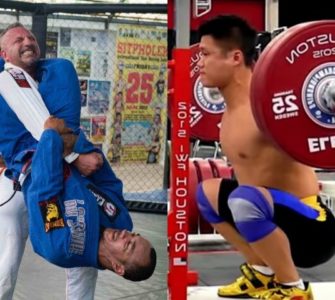Photo: Metamoris 1, Ryron Gracie vs Andre Galvao.
Guest post Tony Pacenski who is a Jiu-Jitsu black belt under Rodrigo Medeiros (BJJ Revolution Team). He runs his academy Soulfight and the excellent website BJJonline.net .Tony is in a unique position as he started learning Jiu Jitsu in his early teens at the Gracie Academy. He eventually became an instructor at BJJ Revolution Team (Carlson Gracie lineage). Since 2014 Tony Pacenski became highly involved in the development of the Jiu Jitsu Global Federation. Tony’s opinion on the matter of Gracie Jiu-Jitsu vs Brazilian Jiu-Jitsu is priceless as he is one of the rare persons to have trained under the Gracie Academy (Helio Gracie), Revolution Team (Carlson Gracie), and under Rickson Gracie.
What is the difference between Gracie Jiu-Jitsu versus Brazilian Jiu-Jitsu? The Armlocks, Chokes and moves of Brazilian Jiu Jitsu (BJJ) are the same as Gracie Jiu-Jitsu. The difference is the teaching method. Here at the Gracie Jiu Jitsu Academy in Torrance, California we strictly endorse the teaching methods of Grand Master Helio Gracie. He believes that there is no such thing as a good or bad student: only good teachers and bad teachers.
Above was the question and answer sequence I was told to memorize, drill and say during introduction lessons at the Gracie Jiu-Jitsu Academy’s instructors training program from 1998 to 2000. Today this explanation still holds truth and value. Gracie Jiu-Jitsu as we were educated to explain was a teaching methodology and not a style of jiu-jitsu; however, it was a style of Jiu-Jitsu different than the Japanese parent styles. In other words, in Brazil, Gracie Jiu-Jitsu was called Jiu-Jitsu. In the United States it was called Gracie Family Jiu-Jitsu, Gracie Jiu-Jitsu or the new term Brazilian Jiu-Jitsu. Therefore at the time, the Gracie Jiu-Jitsu Academy in Torrance differentiated itself apart by its teaching methods and curriculums that taught: Self-Defense, Combatives and Sport Jiu Jitsu.

Roger Gracie Academy is a typical Jiu-Jitsu academy that teaches sport Jiu-Jitsu and limited self defense
As time moved forward, the mass majority of BJJ academies around the world focused their curriculums on sport jiu-jitsu aspects of Jiu Jitsu from Brazil all awhile the Gracie Jiu-Jitsu of Torrance continued to focus on Self-Defense, Combatives and some sport jiu-jitsu aspects of the curriculum, teaching and training methodologies. Today it is very common to walk into 10 BJJ academies and see blue or purples belts students that have never learned how to use Jiu Jitsu from Brazil for street defenses and attacks against punches. In addition, even though an academy’s business name on the building has the Gracie surname does not guarantee that the school focuses on self-defense and combatives in the academy’s curriculum. Each lesson is mostly structured with a warm-up, instructional period and open mat session that is sports-specific year-after-year.

Valente Academy teaches Gracie Jiu-Jitsu more focused on self defense
We arrive today with Gracie Jiu-Jitsu x Brazilian Jiu-Jitsu. There is no difference between Gracie Jiu-Jitsu and Brazilian Jiu-Jitsu in the calling or naming of the style. The differences are in the presentations, principles and philosophies of the instruction for Jiu Jitsu from Brazil. The differences are also in the academy’s curriculum and training focuses. The Armlocks and Chokes of Gracie Jiu-Jitsu and Brazilian Jiu-Jitsu are the same is a very limited and simple answer or expression because overtime Jiu Jitsu in its many forms is not only about techniques. It is much more than that. Knowledgable black belts with tested experience can walk into the Gracie Jiu Jitsu Academy in Torrance, California and question the curriculum’s core techniques just as easily as they can walk into the top sport Jiu Jitsu BJJ academy to question its curriculum. Single techniques will continue to be improved and for those professors that are reading this: Please look at each of your core curriculum techniques and make them better. Yet, the thoughts now are to think of Grand Master Helio Gracie’s examples.
We come to the conclusions as Grand Master Helio Gracie modeled. There are good and bad teachers. There are training environments that teach self-defense and there are not. Some schools have both environments. And as we gain a wider view of Jiu Jitsu from years of experience, all drills, katas, assessments, challenges and refinements have their place, time and purpose as Jiu Jitsu and individuals evolve and learn. Our time and place finds us all failing much more than we succeed. Yet as we learn further, how we view setback, failure, tapping out, winning, gold medals and success changes too with Jiu Jitsu practice. The value of the real lessons found in the academy show us how we can find empowerment which starts at the point where limitations end. Ask yourself if you could escape the mount position during your first Jiu Jitsu lesson? At the beginning of the lesson showed you your limitation…
My best,
Prof. Tony Pacenski
3rd Degree Black Belt
BJJ Revolution Team


















